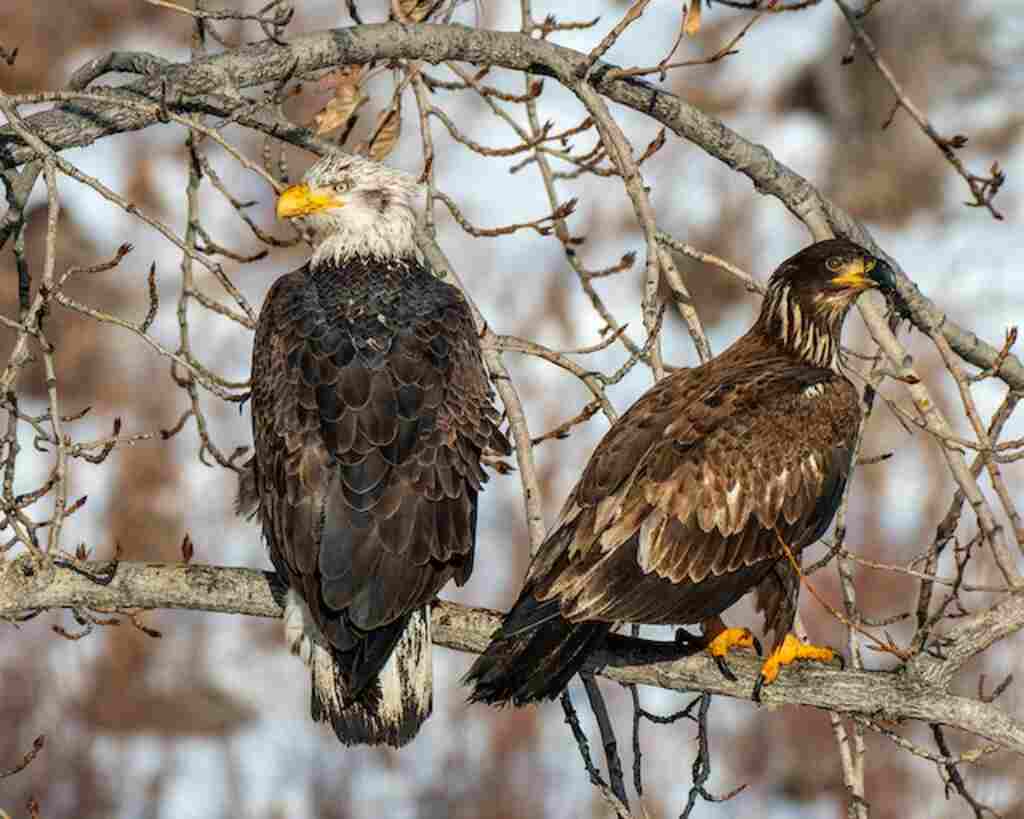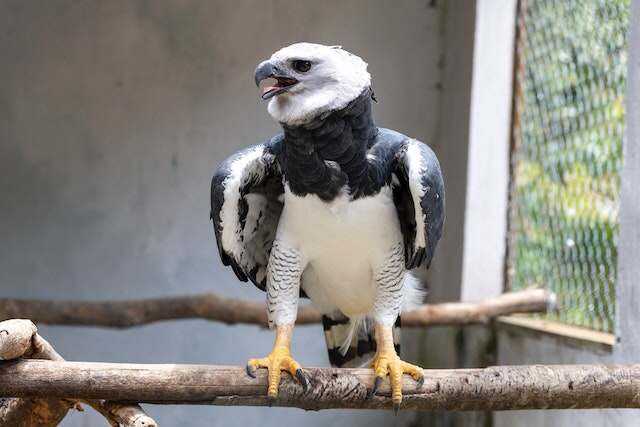How Do Eagles Adapt To Their Environment? Get ready to witness the awe-inspiring ways these majestic birds conquer their surroundings.
From their unparalleled hunting prowess to their graceful mastery of the skies, eagles have captivated humans for centuries.
Unveil the secrets behind their physical, behavioral, habitat, diet, and reproductive adaptations.
Prepare for a wild exploration of their survival tactics!
Table of Contents
- 1 Key Takeaways
- 2 Physical Adaptations
- 3 Behavioral Adaptations
- 4 How Do Eagles Adapt To Their Environment
- 5 Habitat Adaptations
- 6 Diet Adaptations
- 7 Reproductive Adaptations
- 8 Importance of Adaptation
- 9 Threats to Eagle Adaptation
- 10 Conservation Efforts
- 11 Future of Eagle Adaptation
- 12 Frequently Asked Questions
- 12.1 How do eagles communicate with each other?
- 12.2 How long do eagles typically live in the wild?
- 12.3 Are there any cultural beliefs or myths surrounding eagles?
- 12.4 How do eagles play a role in their ecosystem beyond their own survival?
- 12.5 How have human activities impacted eagle populations and their adaptations?
- 13 Conclusion
- 14 Author
Key Takeaways
- Eagles have various physical, behavioral, habitat, feeding, and reproductive adaptations that help them survive and evolve as apex predators.
- Conservation efforts, legal protection, and community involvement have increased eagle populations, but human interference, habitat loss, pollution, and climate change still pose threats to their adaptation and survival.
- Challenges such as competition for resources and risk of predation are significant for gaining evolutionary advantages and passing on beneficial adaptations through natural selection.
- The future of eagle adaptation depends on recognizing and addressing challenges, examining the impact of climate change, maintaining genetic diversity, and understanding their reproductive habits.
Physical Adaptations
Eagles are renowned for their physical adaptations, including sharp talons, keen eyesight, and powerful wings, which enable them to thrive in their diverse environments.
Flight adaptations allow eagles to soar at great heights, using their broad wings to glide effortlessly through the air currents.
Their wingspan can measure up to 7 feet, which is essential for their ability to fly at high altitudes and dive at incredible speeds.
Vision adaptations, on the other hand, allow eagles to spot prey from great distances.
Their eyesight is so keen that they can see prey up to two miles away, and they can also see UV light, which is invisible to humans.
These physical adaptations enable eagles to quickly and effectively hunt their prey, whether it be fish, small mammals, or birds.
These abilities also allow eagles to adapt to a variety of environments, such as mountains, forests, and coastal areas.
Behavioral adaptations, such as their hunting strategies, also play a crucial role in their survival and ability to adapt to their environment.
Behavioral Adaptations
Eagles exhibit a range of behavioral adaptations that contribute to their survival in their respective environments.
One of the most notable behavioral adaptations is their hunting techniques, which vary depending on the species and prey availability.
Additionally, many eagles exhibit migratory patterns, traveling long distances to find food and suitable habitats.
Finally, eagles have unique social structures, with some species living in solitary pairs while others form large communal groups.
These adaptations have allowed eagles to thrive in diverse habitats around the world.
Hunting Techniques
With their keen eyesight and sharp talons, predatory birds such as the eagle have evolved to become skilled hunters, utilizing various techniques to capture prey.
These techniques include:
1) Ambush hunting, where the eagle waits patiently in a hidden location for prey to pass by before swooping down for the kill;
2) Aerial hunting, where the eagle uses its agility and speed to chase down prey in mid-air, often using surprise attacks to catch them off guard;
3) Scavenging, where the eagle feeds on the carcasses of dead animals, particularly when prey is scarce.
Eagles are also known to use camouflage techniques to blend into their surroundings and avoid detection by both prey and predators.
Additionally, they are selective in their prey choices, often targeting weaker or smaller animals.
These hunting techniques have allowed eagles to thrive in a variety of environments, from open plains to dense forests.
As we explore further into the adaptability of eagles, we will delve into their migration patterns.
Migration Patterns
During migration, these majestic birds travel thousands of miles, crossing vast expanses of land and sea to reach their destination.
The timing and route of migration are influenced by various environmental factors such as food availability, weather conditions, and breeding habits.
Eagles generally migrate during the fall and spring, with some species traveling as far as South America from North America.
They use thermals and updrafts to conserve energy and cover great distances, and their keen eyesight and navigation skills help them find their way.
The migration patterns of eagles are important for maintaining genetic diversity and ensuring the survival of the species.
Overall, their remarkable ability to adapt to their environment through migration is one of the many reasons why eagles are such fascinating creatures.
Moving on to their social structure, eagles exhibit interesting behavior in their interactions with each other.
Social Structure
The social structure of eagles is organized according to a dominance hierarchy, with the alpha pair at the top and subordinate birds below them, as observed in a study where 91% of nests had only one breeding pair.
Eagles are monogamous creatures and form long-term partnerships that can last up to several years or even a lifetime.
The alpha pair usually initiates mating, and the subordinate birds help in incubation and feeding the chicks.
The hierarchy among eagles is based on various factors, including size, strength, and experience.
The dominant pair controls the resources, including food and nesting sites, and defends their territory against intruders.
Mate selection is also an essential aspect of the social structure of eagles.
The dominant pair usually mates for life and may change partners only when one of them dies.
The subordinate birds may also mate, but their offspring has a lower chance of survival due to limited resources.
The social structure of eagles plays a crucial role in their survival and reproductive success.
However, it is not the only factor that determines their adaptation to the environment.
In the next section, we will explore how eagles adapt to their habitat.
How Do Eagles Adapt To Their Environment
Eagles are remarkable birds of prey that have evolved various adaptations that enable them to adapt to their environment.
With their sharp, curved beaks and powerful talons, eagles are efficient hunters that can tear apart their prey with ease.
Their excellent eyesight allows them to spot potential prey from great distances, while their broad wingspan and strong, lightweight wings enable them to soar and cover vast distances.
Additionally, their hollow bones enhance flight agility, and dense feathers provide insulation and streamline flight.
These adaptations, combined with their ability to adapt their diets and hunting techniques to available food sources, make eagles perfectly suited to their habitats and formidable predators.
Habitat Adaptations
Eagles have evolved to develop specific habitat adaptations that allow them to thrive in a variety of environments.
These adaptations include nesting habits and territoriality, which are crucial for the survival of eagle populations.
Eagles typically build their nests high up in trees or on cliffs to avoid predators and provide a secure place for their young.
They are also territorial and will fiercely defend their nesting sites, ensuring that they have access to resources such as food and water.
In addition to these behaviors, eagles have physical adaptations that allow them to thrive in their habitats. For example, their sharp talons and beaks are well-suited for hunting and tearing apart prey.
Eagles also have excellent eyesight, which allows them to spot prey from great distances.
Furthermore, their wings are designed for soaring and gliding, which allows them to conserve energy while searching for food.
All of these adaptations have allowed eagles to flourish in a variety of environments, from forests and mountains to deserts and coastlines.
In the next section, we will explore how eagles have adapted their diets to survive in these diverse habitats.
Diet Adaptations
By modifying their feeding habits, eagles have been able to successfully thrive in various ecosystems, showcasing their incredible adaptability.
Using personification, we can say ‘Eagles have become masters of adjusting their palate to suit their surroundings, allowing them to effortlessly conquer multiple habitats.’
Hunting habits vary depending on the species, but eagles are known for their impressive hunting skills.
They are opportunistic predators and will hunt a wide range of prey, from fish in coastal areas to small mammals in forests. Eagles have even been known to prey on other birds, such as ducks and geese.
Their prey preferences are also influenced by the environment, with some species adapting to eat whatever is available.
For example, the bald eagle has been observed scavenging on carrion when prey is scarce.
Overall, eagles have shown incredible flexibility in their hunting habits, allowing them to survive and thrive in diverse environments.
As we move on to the next section, we will explore how eagles have adapted their reproductive strategies to ensure the survival of their species.
Reproductive Adaptations
As previously discussed, the diet of eagles is a crucial adaptation that enables them to survive in their environment. However, another important aspect of eagle adaptation is their reproductive strategy.
Breeding habits and nesting behavior vary between species but generally, eagles mate for life and return to the same nesting site year after year.
Eagles build their nests high in trees or on cliffs, with some species even building them on the ground. The nest is constructed of sticks and lined with softer materials such as grass and feathers.
Both the male and female take turns incubating the eggs and caring for the young. This reproductive adaptation ensures the survival of the species, as well as the continuation of the eagles’ genetic traits.
Understanding the reproductive habits of eagles is important in comprehending the significance of their adaptations in their environment.
Importance of Adaptation
The importance of adaptation cannot be overstated, as it directly affects an organism’s ability to survive and thrive in its environment.
Adaptations are essential for species to evolve and gain evolutionary advantages, such as improved efficiency in obtaining resources and avoiding predators.
Through natural selection, organisms with beneficial adaptations are more likely to pass on their genes to the next generation, leading to the development of new and improved adaptations over time.
Survival
Survival is a critical aspect of the eagle’s adaptation to its environment, as it must be able to locate and capture prey in order to sustain itself.
Eagles have evolved to be apex predators, with sharp talons, keen eyesight, and powerful wings that enable them to soar high in the sky.
Their ability to hunt and scavenge for food has allowed them to adapt to changing environments, including adapting to climate change and the impact of human activity.
However, despite their impressive abilities, eagles still face many challenges in the wild, such as competition for resources and the risk of predation.
It is through their resilience and adaptability that eagles are able to survive and thrive in their natural habitats.
The struggle for survival is not just a matter of life and death for eagles, but a symbol of the innate desire for freedom and autonomy that exists within all living beings.
As we delve into the evolutionary advantages of eagles, we can gain a deeper understanding of how they have overcome the challenges of their environment.
Evolutionary Advantages
Evolutionary advantages have allowed eagles to become highly efficient predators with specialized anatomical features and cognitive abilities.
Eagle vision, for example, is exceptional, with the ability to see prey from great distances and with incredible detail. This allows eagles to spot prey from high in the sky and then swoop down with precision and speed.
Additionally, eagles have strong and agile wings that allow them to soar for hours without getting tired.
Their feather insulation also plays a critical role in their ability to adapt to various environments, from freezing cold to scorching heat.
The shape of their beak is also particularly well-suited for hunting, with a sharp and curved tip that allows eagles to easily tear apart prey.
These evolutionary advantages have allowed eagles to thrive in their environments and become apex predators in their ecosystems.
However, despite their impressive adaptations, eagles still face threats to their survival.
Threats to Eagle Adaptation
Adversely affecting the ability of eagles to adapt to their environment are various factors such as human interference, habitat loss, pollution, and climate change.
Human activities such as deforestation, mining, and urbanization have led to a significant loss of habitat for these birds, reducing their ability to find suitable nesting sites, food sources, and shelter.
Additionally, pollution from industries, agricultural practices, and waste disposal sites has resulted in contaminated water and air, making it difficult for eagles to find clean water and prey.
Climate change has also posed a significant threat to eagle populations, altering their breeding patterns, migration routes, and food availability.
These changes have resulted in population declines and changes in behavior and distribution patterns.
Conservation efforts are necessary to mitigate the negative effects of these threats and ensure the survival of these magnificent birds.
Conservation Efforts
Despite the numerous threats facing eagles, conservation strategies have been implemented to ensure their survival.
These strategies involve community involvement, such as habitat restoration and protection, monitoring populations, and reducing human impacts on eagle habitats.
For instance, the Bald and Golden Eagle Protection Act of 1940 prohibits the killing, possession, or sale of eagles and their parts.
Furthermore, the Endangered Species Act of 1973 provides legal protection for endangered and threatened species, including eagles.
These conservation efforts have resulted in a significant increase in eagle populations, with the bald eagle being removed from the endangered species list in 2007.
However, ongoing efforts are still needed to ensure that eagle populations continue to thrive in their environment.
The future of eagle adaptation depends on the continued implementation of effective conservation strategies and community involvement in protecting these magnificent birds.
Future of Eagle Adaptation
The continued success of eagle populations in the face of environmental challenges will depend on the effectiveness of ongoing conservation efforts and community involvement.
To ensure the adaptation of eagles to their environment in the future, there are several possible discussion ideas that need to be considered.
Firstly, the impact of climate change on eagle populations needs to be examined. As the climate changes, the habitats of eagles may be affected, and their prey may become scarce or may migrate to other areas.
This may lead to a decline in eagle populations if they are unable to adapt to these changes.
Secondly, genetic diversity needs to be taken into account. Inbreeding can lead to genetic defects and reduced population growth, which can ultimately lead to extinction.
Therefore, it is important to maintain genetic diversity to ensure the long-term survival of eagle populations.
Overall, the future of eagle adaptation will depend on our ability to recognize and address these challenges.
Frequently Asked Questions
How do eagles communicate with each other?
Eagles communicate with each other through visual cues and vocal signals. They use body language, such as flapping their wings or changing their posture, to send messages. They also emit high-pitched calls for long-distance communication.
How long do eagles typically live in the wild?
The impressive lifespan of eagles, which varies by species, can range from 15 to 30 years in the wild. The habitat preferences of eagles play a significant role in their longevity, as they require open areas for hunting and nesting.
Are there any cultural beliefs or myths surrounding eagles?
Eagles hold significant cultural symbolism in many societies, representing strength and freedom. Some cultures have utilized eagle hunting practices for centuries. These beliefs and practices have contributed to the conservation efforts of the species.
How do eagles play a role in their ecosystem beyond their own survival?
Eagles play a crucial role in their ecosystem beyond their own survival through their hunting behavior and prey selection. They help to regulate and maintain prey populations, preventing overgrazing and allowing for a healthy balance in the food chain.
How have human activities impacted eagle populations and their adaptations?
What impact has human intervention had on eagle populations and their adaptations? Human activities such as habitat destruction, pollution, and hunting have affected natural selection, leading to changes in behavior, diet, and reproductive success.
Conclusion
The adaptation of eagles to their environment is a remarkable process that showcases the resilience and adaptability of these magnificent birds.
Physical adaptations such as sharp talons and keen eyesight aid in hunting prey, while behavioral adaptations like soaring and territorial behavior ensure survival.
Habitat adaptations involve nesting in tall trees and living near water sources, while diet adaptations include eating a variety of prey species.
Reproductive adaptations include selecting mates and building nests.
The importance of adaptation cannot be underestimated, as it is crucial for the survival of eagles in their environment.
However, threats such as habitat destruction, pollution, and hunting pose a danger to their adaptation.
Conservation efforts such as habitat restoration and protection, captive breeding, and education programs are necessary to safeguard the future of these majestic birds.
Ironically, despite the challenges eagles face, humans continue to be fascinated by them. From national emblems to sports teams, eagles have become ingrained in human culture.
But it is important to remember that this fascination should not come at the expense of their adaptation.
As we strive to learn more about these birds, it is crucial that we also take action to protect their environment and ensure their survival.
Only then can we truly admire the adaptability of eagles in their natural habitat.







